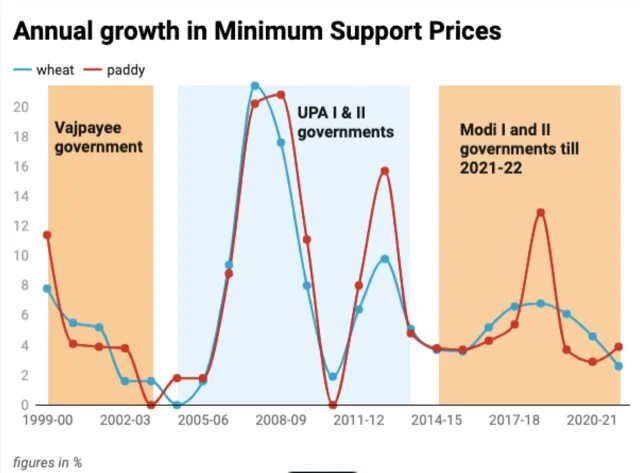UPSC Articles
AGRICULTURE/ GOVERNANCE
Topic:
- GS-3: Issues related to direct and indirect farm subsidies and minimum support prices and food security
Are ‘remunerative’ MSPs boosting rural demand?
Context: On June 9, the union cabinet approved Minimum Support Prices (MSP) for the 2021-22 kharif marketing season.
- MSP for paddy will be ₹1940 per quintal, compared to ₹1868 last year.
- Cabinet Committee on Economic Affairs (CCEA) says that the latest MSP offers a 50% mark-up over the projected cost of cultivation in 2021-22.
The cost measures used in calculating MSP
| A2 | All the types of cash expenditure to generate the crop like seeds, manure, chemicals, labour costs, fuel costs and irrigation costs. |
| A2+FL
(Used by government) |
It includes A2 plus an imputed value of unpaid family labour. |
| C2
(demanded by farmers) |
This includes A2+FK and the imputed rental value of owned land and interest on value of owned fixed capital, thereby including the opportunity cost of practising agriculture. |
Issues
- Nominal growth in MSPs has been low in recent years
- Although the government claims that latest MSP announcements fulfil the 50% mark-up over A2+FL criteria, the increase in nominal terms is not much.
- Paddy and wheat MSPs for the 2021-22 kharif and rabi marketing seasons have increased by 3.9% and 2.6% respectively.

- Nominal MSPs are not enough to access the demand impact
- MSPs, directly or indirectly (in terms of creating a price floor), affect the prices received by farmers, and hence their nominal incomes.
- Demand, on the other hand, is a function of purchasing power, which is determined by relative prices.
- Terms of trade index captures the ratio of index of prices received by farmers and prices paid by farmers for purchase of goods (consumption, intermediate and capital goods). A value less than 100 signifies a worsening of terms of trade
- The statistics show that terms of trade were improving for farmers from 2004-05 to 2010-11, stagnated at unfavourable levels till 2016-17, and started declining after that.
- Deteriorating Terms of trade for farmers have been leading to a squeeze on their purchasing power. Of course, the situation would be worse if MSPs did not exist.
- Wages account for more than 60% and almost one-third of A2+FL cost of cultivation for paddy and wheat. Rural wages, which were rising at a fast pace until 2014-15, have stagnated in the recent past
- If agricultural labour and farmers experience a squeeze on income (rural wages and imputed value of wages), this will put a pressure on purchasing power and therefore rural component of aggregate demand, including that for farmers.

- Headwinds in future
- Two factors might further worsen the terms of trade for farmers going forward.
- The profit-led nature of recovery and poor labour market conditions in the post-pandemic phase will further squeeze mass incomes and hence demand for food items, putting downward pressure on prices.
- A rise in the cost of items such as diesel and some fertilisers (the government has announced a hike in subsidies for urea) could lead to the actual cost of cultivation being higher than the projected costs used for calculating the latest MSPs.
- Farm sector is the shock absorber in terms of the labour market and the longer it takes for the non-farm labour market to recover, the more difficult the farm sector will find to cushion incomes
What should government do going forward?
- It is unrealistic to think that the farm economy will keep delivering even though the non-farm part is in crisis
- This is why it is important that the government provides a fiscal stimulus to both the labour-intensive component of both farm and non-farm sectors.
Connecting the dots:













